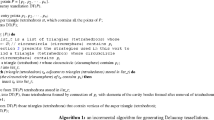Abstract
This paper presents a new incremental insertion algorithm for constructing a Delaunay triangulation. Firstly, the nearest point is found in order to speed up the location of a triangle containing a currently inserted point. A hash table and 1–3 deterministic skip lists, combined with a walking strategy, are used for this task. The obtained algorithm is compared with the most popular Delaunay triangulation algorithms. The algorithm has the following attractive features: it is fast and practically independent of the distribution of input points, it is not memory demanding, and it is numerically stable and easy to implement.
Similar content being viewed by others
Explore related subjects
Discover the latest articles and news from researchers in related subjects, suggested using machine learning.References
de Berg M, van Kreveld M, Overmars M, Schwarzkopf O (1997) Computational geometry: algorithms and applications. Springer, Berlin Heidelberg, New York
Dwyer RA (1987) A faster divide-and-conquer algorithm for constructing Delaunay triangulations. Algorithmica 2(2):137–151
Edelsbrunner H, Seidel R (1986) Voronoi diagrams and arrangements. Discrete Comput Geom 1(1):25–44
Fang T-P, Piegl L (1992) Algorithm for Delaunay triangulation and convex–hull computation using a sparse matrix. Comput Aided Des 24(8):425–436
Fang T-P, Piegl L (1993) Delaunay triangulation using a uniform grid. Comput Graph Appl 13(3):36–47
Fortune S (1987) A sweep-line algorithm for Voronoi diagrams. Algorithmica 2:153–174
Guibas L, Stolfi J (1985) Primitives for the manipulation of general subdivisions and the computation of Voronoi diagrams. ACM Trans Graph 4:75–123
Guibas L, Knuth D, Sharir M (1992) Randomised incremental construction of Delaunay and Voronoi diagrams. Algorithmica 7:381–413
Huang C-W, Shih T-Y (1998) Improvements on Sloan’s algorithm for constructing Delaunay triangulations. Comput Geosci 24(2):193–196
Kolingerová I, Žalik B (2002) Improvements to randomized incremental Delaunay insertion. Comput Graph J 26(3):477–490
Lawson CL (1977) Software for C1 Surface Interpolation. In: Price JR (ed) Mathematical Software III. Academic, New York, pp 161–194
Lee DT, Schachter BJ (1980) Two algorithms for constructing a Delaunay triangulation. Int J Comput Inf Sci 9(3):219–242
Mücke EP, Saias I, Zhu B (1996) Fast-randomized point location without preprocessing and two- and three-dimensional Delaunay triangulations. In: Computational Geometry ’96. ACM Press, Philadelphia, pp 274–283
Munro JI, Papadakis T, Sedgewick R (1992) Deterministic skip lists. In: Proceedings of the 3rd ACM-SIAM symposium on discrete algorithms, pp 367–375
Pugh W (1990) Skip lists: a probabilistic alternative to balanced trees. Commun ACM 33(6):668–676
Shewchuk JR (1996) Triangle: engineering a 2D quality mesh generator and Delaunay triangulator. In: 1st workshop on applied computational geometry. Association of Computing Machinery, Philadelphia, pp 124–133
Shewchuk JR (2001) http://www-2.cs.cmu.edu/∼quake/triangle.html A two–dimensional quality mesh generator and delaunay triangulator. Accessed 1 February 2003
Sloan SW (1987) A fast algorithm constructing Delaunay triangulations in the plane. Adv Eng Softw Workstat 9(1):34–55
Su P, Drysdale RLS (1995) A comparison of sequential Delaunay triangulation algorithms. In: Proceedings of the 11th annual symposium on computational geometry. ACM Press, New York, pp 61–70
Žalik B, Kolingerová I (2003) An incremental construction algorithm for Delaunay triangulation using the nearest-point paradigm. Int J Geograph Inf Sci 17(2):119–138
Author information
Authors and Affiliations
Corresponding author
Rights and permissions
About this article
Cite this article
Zadravec, M., Žalik, B. An almost distribution-independent incremental Delaunay triangulation algorithm. Visual Comput 21, 384–396 (2005). https://doi.org/10.1007/s00371-005-0293-3
Published:
Issue Date:
DOI: https://doi.org/10.1007/s00371-005-0293-3




